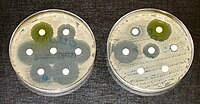
Photo from wikipedia
BACKGROUND It is largely unknown how frequently minor HIV drug-resistant variants at levels under limit of detection of conventional genotyping are present in patients experiencing virological failure (VF). Further, the… Click to show full abstract
BACKGROUND It is largely unknown how frequently minor HIV drug-resistant variants at levels under limit of detection of conventional genotyping are present in patients experiencing virological failure (VF). Further, the clinical implications of minor drug-resistant variants at time of virologic failure are unknown. METHODS Fifteen patients experiencing VF on a first-line regimen were evaluated by high-throughput sequencing and compared with the conventional Sanger genotype drug resistance detection method. RESULTS NRTI drug resistant mutations (DRMs) were detected in a high proportion of subjects, with the most common being M184V and TAMs. Minor resistant mutations accounted for 19.27% of the total drug-resistant mutations in patients with VF. A mean of 1.7 additional mutations per subject were detected by high-throughput sequencing, the difference was statistically significant, and those additional low-abundance drug-resistant mutations increased the genotypic resistance scores in 10 of 11 subjects (90.9%). Among persons experiencing VF, minor variants possessing major PI (protease inhibitor) DRMs were present in a minority of cases, which was also the case in ARV-naive subjects, and suggests PIs may be effective in subjects experiencing VF on subsequent second-line PI-based antiretroviral regimen. The high-throughput sequencing results of mutations between ART failure subjects and treatment naïve subjects were also compared. Three novel mutations were then screened with higher frequencies in the ART failure subjects. CONCLUSIONS It is important to guide the replacement of treatment programs and screening for new drug-resistant mutation sites, and the use of high-throughput sequencing methods can more comprehensively study the characteristics of drug-resistant viral variants of patients experiencing VF on a first-line regimen.
Journal Title: Annals of palliative medicine
Year Published: 2021
Link to full text (if available)
Share on Social Media: Sign Up to like & get
recommendations!